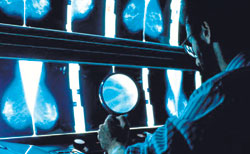With more and more women becoming aware of the need to get screened for diseases like breast cancer, it is important to have some knowledge on mammograms.
There are two types of mammograms -- a 'screening mammogram' and a 'diagnostic mammogram'.
A screening mammogram is used to detect breast changes in women who have no signs or symptoms of breast cancer and involves two views of each breast. It does not need a doctor's referral.
 |
| A radiologist reporting on a mammogram. |
A diagnostic mammogram, on the other hand, needs a referral from a doctor and is carried out when the patient has signs and symptoms of breast cancer which include breast pain, nipple discharge, skin thickening and a sudden change in the size and the shape of the breasts.
The early detection of small breast cancers by a screening mammography greatly improves a woman's chances of getting treatment successfully.
Studies conducted internationally have revealed that deaths from breast cancer could be cut down by 36% to 44% if a screening mammography was performed annually on women who are older than 40 years. That is why medical experts recommend a yearly mammogram.
In mammography, X-rays are used to image the breasts, thus making it possible to detect tumours that cannot be felt and also to find micro calcifications (small deposits of calcium in the breast).
A woman with a strong family history of breast cancer should get a mammogram done at the age of 30 or less than 10 years of the age of the family member's diagnosis of breast cancer, whichever comes first.
The risk of breast cancer increases gradually as a woman gets older. However, the risk of developing breast cancer is not the same for all women. Research has shown that several factors increase a woman's chance of developing a cancer.
- Personal history of breast cancer - women who have had breast cancer are more prone to develop a second breast cancer.
- Family history - a woman's chance of developing breast cancer increases if her mother, sister and/or daughters have a history of breast cancer (especially if they were diagnosed before age 50) or ovarian cancer.
- Breast biopsies revealing pre -cancerous or high-risk tissues
- Genetic alterations - specific alterations in certain genes increase the risk of breast cancer.
- Reproductive and menstrual history - women who began having their periods before age 13 or went through menopause after age 55 are at an increased risk. Women who have their first child after 35 or who never have a child are at increased risk of developing breast cancer.
- Long-term use, more than five years, of hormone replacement therapy
- Dense breasts, radiation therapy to chest as in lymphoma, body weight and physical activity level are some other factors that increase the chance of developing breast cancer.
Many women are concerned about the exposure to X-rays during a mammography but should be assured as modern mammography systems use extremely low levels of radiation.
The benefit of mammography for the early detection and treatment of breast cancer outweighs the minimal risk of radiation received during mammography and the discomfort that some women experience due to breast compression.
To put a mammography dose into perspective a woman who receives radiation therapy as a treatment for breast cancer will receive 40 to 60 Grays. Gray is the SI unit for radiation absorbed dose. If a woman had an annual screening mammography for 50 years beginning at the age of 40 and continuing until the age of 90, she will receive a total of 0.1 gray to 0.2 gray of radiation per breast over the course of 50 years. Therefore, there is no significant risk of radiation involved.
 |
| A woman undergoing the procedure – Images courtesy Getty |
Although a mammography is the most accurate method for early detection it has its limitations.
Finding cancer does not always mean saving lives. Even though a mammography can detect tumours that cannot be felt, finding a small tumour does not always mean that a woman's life will be saved, especially, if it is an aggressive cancer that has already spread to the other parts of her body before being detected.
False negatives could also occur when mammograms appear normal even though breast cancer is present. This occurs more often in younger than in older women because the dense breasts of young women make cancers more difficult to detect in mammograms.
False positives could also occur when a mammogram is read as abnormal, but no cancer is actually present. All abnormal mammograms should be followed up with additional investigations (an ultrasound and/or biopsy) to determine whether cancer is present. False positives are common in younger women, women who have had previous breast biopsies, women with a family history of breast cancer and women who are taking hormone therapy.
Facilities at Sri Jayewardenepura Hospital
The 1032-bed Sri Jayewardenepura General Hospital & Post Graduate Medical Training Centre, Kotte is equipped with modern facilities and women who wish to get high quality screening or a diagnostic mammogram could do so at the Department of Radiology under the guidance of a female Consultant Radiologist. X- ray imaging of breasts are done by a well-trained female radiographer.
The time taken for a mammogram is about 30 minutes and this facility is available from Monday to Saturday.
The department also offers further investigations such as guided biopsies following a positive mammogram or an ultra sound scan and referral to a breast/surgical clinic.
(The writer is a Consultant Radiologist at the Sri Jayewardenepura General Hospital)
|


